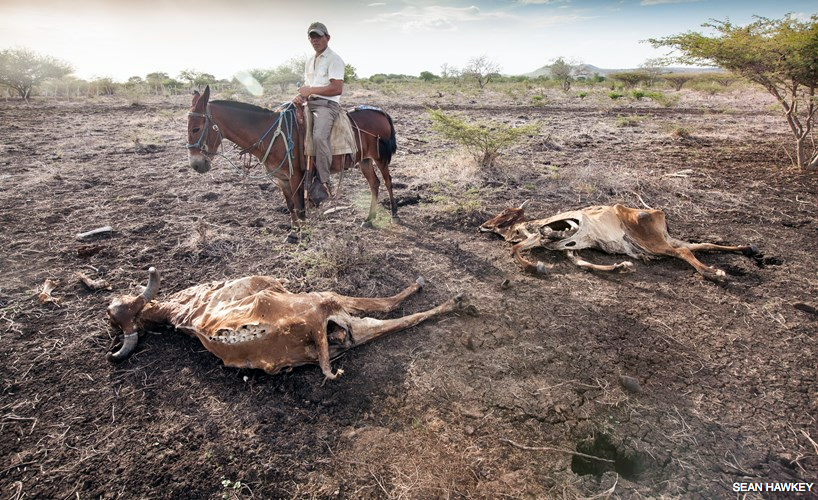Climate change is the main driver of mass migration of peoples around the world. Our own region is most vulnerable of all.

As Donald Trump says, desperate people seeking to enter the US from Mexico signify an emergency. But it’s an emergency like nothing he’s ever imagined.
People moving northward out of Nicaragua, Honduras and El Salvador are fleeing gang violence and poverty, but there’s a deeper cause that the president has overlooked or ignored. And in a future not so far away, that deeper cause could see those thousands turn to millions.
People are being driven out of Central America and the Caribbean by natural disaster and food scarcity. Of the 10 nations in the world rated by climate monitoring institute Germanwatch as being most at risk from climate change, half are in this relatively small region.
Last year the world was shocked by an Intergovernmental Panel on Climate Change report on the impact of 1.5C of warming. But an Australian analysis released last week found that the IPCC underestimated that impact, and that the real story is even more shocking.
Preparing for the Era of Disasters, a special report for the Australian Strategic Policy Institute by Robert Glasser, asserts that the IPCC, by treating climate hazards independently of each other rather than as interacting variables, failed to account for compounding and cascading impacts.
A classic instance of cascading effects of climate change is the devastating civil war in Syria, which according to studies cited by Glasser was made several times more likely by climate change.
Massive crop failures on the back of an exceptionally severe four-year drought undermined livelihoods and forced 1.5 million Syrians to leave their land and move into cities, increasing social stresses. Just as happened in Central America leading to the Mexican “caravans”.
But those calamities may be just a curtain-raiser to what is in store in our own back yard. Hundreds of millions of people to our north face an array of daunting prospects.
A vital source of food for more than 130 million people are the fish caught in ocean waters to our north, waters that spawn about 10 per cent of all the world’s fish supply.
At 2C of warming, says Glasser, the death of coral reefs and a collapse in tropical fishery yields will have global consequences for food security. That’s aside from a rising impact across Asia of crop pests, droughts, wildfire, extreme rainfall and storm events, and inundation by rising seas.
An increase in concurrent or cascading extreme weather events will be a feature of the coming “era of disasters”, says the report. Communities may manage the first few events, but in a weakened state are likely to be overwhelmed by those following.
The report emphasised that governments think they have time to spare when they don’t. It called for urgent steps by all levels of government in Australia, starting now, to face these unprecedented challenges and help mitigate the inevitable damage from climate disasters.
Glasser’s analysis, written for an impeccably-credentialled conservative think-tank founded by the Howard government, is reason for every jurisdiction in the world to sit up and take notice.
We are now in a climate emergency, a fact well-founded in science. We can throw up our hands in despair at this prospect, or we can follow the lead of Darebin, a Melbourne suburban council, which in 2017 declared a climate emergency.
The Climate Emergency movement calls on local government entities around the world to do their utmost to mitigate climate change. But its greatest impact may be in putting pressure on higher levels of government to stand up to be counted.
At last count 369 jurisdictions administering over 31 million people across Australia, North America and the United Kingdom, including the City of London, had declared a climate emergency for their municipality. In the past month the movement has penetrated Europe.
In Australia, climate emergency declarations have been made by eight councils and the state municipal associations of Victoria and Western Australia. None has so far taken the plunge in Tasmania, but that is surely just a matter of time, and leadership.
This week, Australia’s lord mayors are meeting in Hobart to discuss matters of importance to our capital cities. The best thing they could do right now is to throw their personal support behind climate emergency declarations for their cities. Nothing on their agenda could be more important.
We know this is not enough. We know that right now, at 1C of warming, the climate is showing signs of instability, and that long-term fossil fuel investment is cementing that danger into place.
We know that to deal with this huge threat, the full panoply of national and international systems of governance must be transformed and engaged. We need those systems to act, just as they need our support to survive and function.
As the threats mount, nations and people within them have begun to put up walls, real or psychological. We keep being told by those in power about the “national interest”, which dictates that we cannot afford to act decisively to cut emissions.
The truth is, we cannot afford not to.
